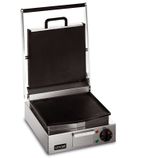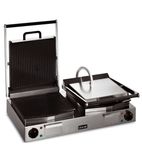Contact Grills & Panini Grills
Contact grills and panini grills have grown in popularity tremendously over recent years, with a huge increase in demand for toasted products a step in class above the humble toasted sandwich. Paninis are quick and easy to produce, make good margin, and customers love them. There is a great deal more that can be done with your contact grill than just paninis, however.
Our extensive, all electric range of double or single contact grills are produced by the likes of trusted general catering brands like Lincat, to grill specialists like Roller Grill. Whatever your requirements for fast, low fat grilled foods we have a product to suit your budget and the volume of your catering operation.
![]() * Items marked with the 'Order Today Delivered Tomorrow' graphic qualify for Next Day Delivery only if the item is ordered before the Next Day Delivery cut off time shown on the product page. Some Next Day Delivery services are chargeable.
* Items marked with the 'Order Today Delivered Tomorrow' graphic qualify for Next Day Delivery only if the item is ordered before the Next Day Delivery cut off time shown on the product page. Some Next Day Delivery services are chargeable.


